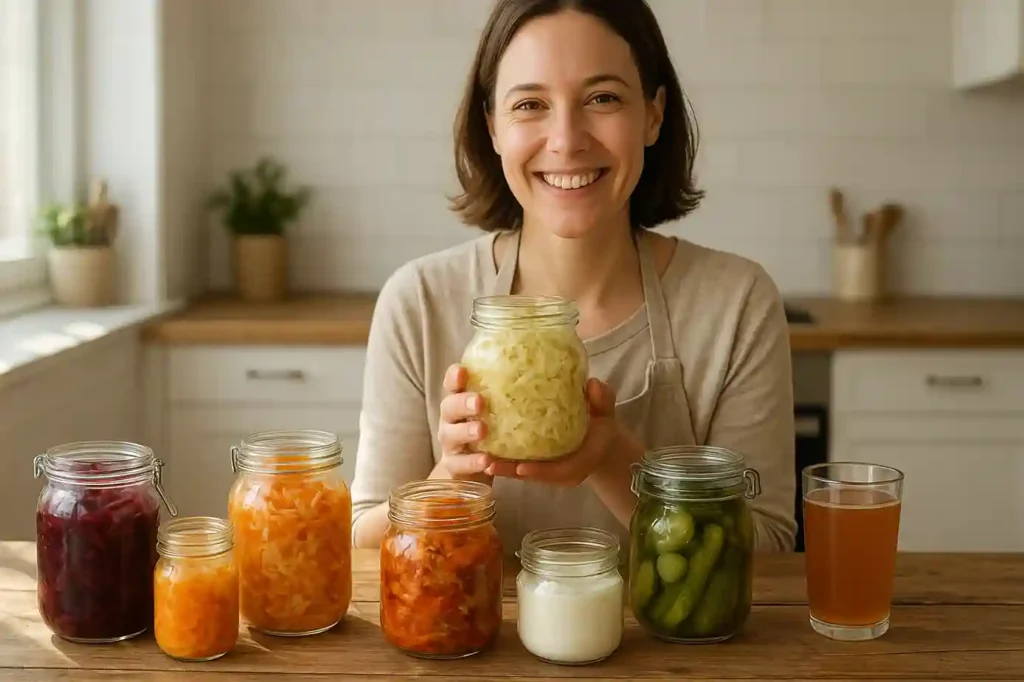The best foods to ferment at home are easy to make, delicious, and full of health benefits. Fermentation is a natural process where microorganisms break down sugars into acids, gases, or alcohol. This simple transformation creates unique flavors, preserves food, and adds valuable probiotics.
Fermenting at home is not complicated. With just jars, salt, and fresh ingredients, you can create nutritious staples. The process is safe, beginner-friendly, and requires little equipment. Beyond health, fermentation is fun—it allows you to experiment with flavors and connect with traditions practiced worldwide for centuries.
What Is Fermentation and Why It Matters

Fermentation is a natural process where bacteria or yeast transform sugars into acids, gases, or alcohol. This simple reaction changes the texture, taste, and shelf life of food. Cultures around the world have relied on it for thousands of years to keep food safe and flavorful. One of the biggest benefits of fermentation is probiotics. These live microorganisms help balance gut bacteria, improve digestion, and support immunity. Along with health benefits, fermentation deepens flavor. Tangy sauerkraut, bubbly kombucha, and earthy miso are all results of this ancient practice.
Starting at home is easier than it sounds. Most recipes need only fresh ingredients, salt, clean water, and a jar. No special tools are required. With a little patience, anyone can create their own probiotic-rich foods right in the kitchen.
Fermentation isn’t just about taste—it also supports health. Fermented foods introduce probiotics, which help balance gut bacteria and improve digestion. According to the U.S. Department of Veterans Affairs, probiotics from fermented foods may strengthen immunity, enhance nutrient absorption, and promote overall wellness.
Best Foods to Ferment at Home
Many everyday foods ferment beautifully. Vegetables, dairy, grains, and drinks all become tastier and more nutritious when fermented. For beginners, the best foods to ferment at home include sauerkraut, yogurt, kombucha, and sourdough bread. These options are easy to manage and highly rewarding.

Fermented Vegetables: Crunchy and Nutritious
Vegetables are the easiest starting point for beginners. They need little equipment, ferment quickly, and deliver consistent results. Cabbage is the classic choice. With only salt and time, it transforms into sauerkraut, a tangy, probiotic-rich staple. In Korea, kimchi takes cabbage further by adding chili, garlic, ginger, and other spices. Both options are packed with vitamins, fiber, and live cultures.
Beyond cabbage, many vegetables ferment beautifully. Carrots remain crisp and slightly sweet, making them perfect for snacking. Cucumbers develop into familiar sour pickles, a favorite across cultures. Beets take on an earthy, deep flavor that adds color and nutrients to meals. These options are simple, versatile, and easy to adapt with herbs and spices.
Vegetable fermentation usually takes only a few days at room temperature. Once bubbles appear and flavors deepen, they are ready to enjoy. Properly stored in the refrigerator, fermented vegetables stay fresh for weeks. Each jar you prepare becomes a convenient source of crunch, flavor, and gut-friendly bacteria.
Fermenting Dairy: Creamy and Tangy Choices

Dairy fermentation offers some of the richest and most versatile options. Yogurt remains the most popular. It requires only milk and a starter culture, which introduces beneficial bacteria. Within hours, plain milk transforms into a thick, tangy food filled with probiotics.
Kefir is another excellent choice. It uses kefir grains, a mix of bacteria and yeast, to ferment milk. Unlike yogurt, kefir is drinkable and slightly effervescent. It ferments faster than yogurt and provides a wider range of beneficial microbes. Many people enjoy it as a refreshing beverage or base for smoothies.
Soft cheeses can also be fermented at home. Options like paneer or fresh cream cheese develop a delicate tang and creamy texture. They offer protein, calcium, and probiotics while remaining easier to digest than fresh milk. These cheeses fit easily into daily meals, from spreads to cooking bases.
For beginners, yogurt is often the best starting point. All you need is warm temperature, patience, and clean jars. Within a day, you’ll have a fresh, customizable yogurt that beats store-bought versions in flavor and nutrition. It’s an easy way to practice fermentation while enjoying a reliable, healthy staple.
Homemade Fermented Drinks You’ll Love

Fermented drinks are among the most refreshing ways to explore fermentation. They combine natural fizz, tangy flavors, and probiotics that support gut health. Many traditional cultures have relied on these beverages not just for taste, but also for their nutritional benefits. Today, they’re simple enough to prepare in any kitchen.
Kombucha is the most well-known option. It starts with sweetened tea and a SCOBY, a symbiotic culture of bacteria and yeast. Over several days, the mixture transforms into a tangy, slightly fizzy drink. The flavor can be customized by adding fruits, spices, or herbs during a second fermentation. Each batch feels unique, which keeps the process exciting.
Water kefir offers a lighter alternative. Made by fermenting sugar water with kefir grains, it creates a bubbly, mildly sweet drink. Additions like lemon, ginger, or fresh berries enhance the taste. Because it ferments faster than kombucha, water kefir is ideal for beginners who want quick results.
For something traditional, ginger beer is a perfect choice. It uses ginger root, sugar, and water to create natural carbonation. Unlike commercial versions, homemade ginger beer is free from artificial additives. It develops a sharp, warming flavor that pairs well with both sweet and savory meals. These drinks are fun, safe, and endlessly customizable. With practice, you can craft flavors that rival or even surpass store-bought varieties. Each sip delivers not only refreshment but also beneficial microbes that support health.
Comparison of Popular Homemade Fermented Drinks
| Drink | Base Ingredients | Fermentation Time | Flavor Profile | Probiotic Level | Beginner Friendly |
|---|---|---|---|---|---|
| Kombucha | Tea + sugar + SCOBY | 7–14 days | Tangy, fizzy, versatile | High | Moderate |
| Water Kefir | Sugar water + kefir grains | 1–3 days | Light, mildly sweet, customizable | Medium | Easy |
| Ginger Beer | Ginger root + sugar + water | 2–5 days | Spicy, sharp, refreshing | Medium | Easy |
Legumes and Grains: Protein-Rich Ferments

Legumes and grains ferment beautifully, creating foods that are both nourishing and full of character. Tempeh is a standout example. Made from soybeans, it is a staple in Indonesian cuisine. Its firm texture, nutty flavor, and high protein content make it popular with both vegetarians and meat-eaters. Tempeh is versatile and works well in stir-fries, sandwiches, and salads.
Miso is another legendary ferment. This soybean-and-grain paste adds a deep umami flavor to soups, marinades, and sauces. It develops during months of fermentation, producing a rich, salty taste layered with complexity. A spoonful of miso can transform simple dishes into flavorful meals.
Sourdough bread is equally beloved. Natural yeasts and lactic acid bacteria break down flour, creating a tangy loaf with a chewy texture. This process makes bread easier to digest and helps it stay fresh longer. For many bakers, maintaining a sourdough starter becomes both a craft and a tradition.
While these foods require more patience than quick vegetable ferments, the results are deeply rewarding. They highlight how fermentation transforms humble beans and grains into protein-rich staples that nourish the body and enrich daily meals.
Comparison of Popular Fermented Legumes and Grains
| Food | Base Ingredients | Fermentation Time | Flavor Profile | Texture | Common Uses |
|---|---|---|---|---|---|
| Tempeh | Soybeans + starter culture | 1–3 days | Nutty, earthy | Firm, dense | Stir-fries, grills, salads |
| Miso | Soybeans + grains + koji | Months to years | Rich, salty, umami | Thick paste | Soups, marinades, sauces |
| Sourdough | Flour + water (starter) | Ongoing starter | Tangy, slightly sour | Chewy, airy loaf | Bread, pizza, baking |
Spices and Condiments to Ferment
Fermented condiments add bold flavor and transform simple meals into something memorable. Hot sauces are a favorite example. By fermenting chili peppers, salt, and garlic for a few weeks, you develop complex layers of heat and tang. Each batch can taste different depending on the peppers and spices you choose, which makes it fun to experiment.
Relishes are another great option. They combine chopped vegetables, herbs, and spices into spreads that ferment into rich, tangy blends. Fermented relishes pair beautifully with grilled foods, sandwiches, or grain bowls, offering both crunch and flavor.
Pickles remain the most familiar condiment. All you need are cucumbers, salt brine, and patience. Unlike vinegar pickles, naturally fermented pickles rely on lactic acid bacteria. This gives them probiotics and a bold, sour flavor that feels alive on the palate.
These condiments are ideal for small-batch experiments. They take up little space, require minimal equipment, and are ready within days or weeks. Each jar becomes a flavorful way to enhance everyday dishes while also delivering gut-friendly benefits.
Comparison of Popular Fermented Condiments
| Condiment | Base Ingredients | Fermentation Time | Flavor Profile | Common Uses |
|---|---|---|---|---|
| Hot Sauce | Chili peppers, salt, garlic | 2–4 weeks | Spicy, tangy, complex | Tacos, marinades, noodles |
| Relish | Vegetables, herbs, spices | 5–10 days | Tangy, savory, crunchy | Sandwiches, burgers, bowls |
| Pickles | Cucumbers + salt brine | 5–14 days | Sour, bold, probiotic | Snacks, salads, side dishes |
Beginner Tips for Fermenting Success
Cleanliness is the foundation of safe fermentation. Always begin with clean jars, utensils, and hands. Even small traces of contamination can ruin a batch. Salt ratios are equally important. Too little salt encourages mold and harmful bacteria, while too much salt slows or even stops fermentation. Following reliable recipes helps you find the right balance.
Ferments need protection but also airflow. Keep vegetables submerged under brine and use a fermentation weight if possible. A loosely fitted lid or special airlock allows gases to escape while keeping contaminants out. Store jars in a cool, dark place at room temperature until you notice signs of activity. Bubbles, sour aromas, and slight changes in color all signal that fermentation is working.
Tasting is one of the best tools you have. Flavors change daily, so sample your ferment to find the stage you prefer. Some people enjoy mild tang, while others prefer a sharp, sour taste. Once your ferment tastes right, transfer it to the refrigerator. Cooler temperatures slow down microbial activity, extend shelf life, and keep flavors stable.
Patience and observation are key. Every kitchen has its own rhythm, and each ferment behaves a little differently. With practice, you’ll learn to recognize the signs of success and enjoy the process as much as the results.
Common Mistakes to Avoid
Beginners often face small but preventable mistakes. Salt is one of the most common issues. Adding too much salt can halt fermentation completely, leaving food overly salty and lifeless. Using too little salt has the opposite effect, encouraging harmful bacteria to grow. Balance is essential, and following tested recipes helps maintain safety.
Air exposure is another frequent problem. Fermented vegetables should always stay submerged under brine. Any part of the food left uncovered can grow mold. While harmless white yeast, called kahm yeast, may appear, it should be skimmed off. True mold looks fuzzy and can be green, black, or pink. If mold develops, the batch is unsafe and must be discarded.
Trusting your senses is the best safeguard. Ferments should smell pleasantly sour, taste tangy, and appear vibrant in color. If food smells rotten, feels slimy, or shows unusual colors, it is unsafe to eat. It’s better to start again than risk illness.
Avoid rushing the process. Many beginners open jars too often or move ferments to the refrigerator before flavors fully develop. Patience allows beneficial microbes to work, creating deeper taste and more reliable results. With practice, these mistakes become rare, and every batch feels easier.
Troubleshooting Common Fermentation Problems
| Problem | Likely Cause | Solution |
|---|---|---|
| Food tastes too salty | Too much salt used | Reduce salt next batch; dilute brine slightly if still fermenting |
| Food not fermenting | Too much salt or too cold room | Check salt ratio; move jar to warmer spot |
| Mold forming on top | Food exposed to air | Keep ingredients submerged; use a weight |
| White film (kahm yeast) | Natural yeast growth | Skim off surface; safe to eat if smell is normal |
| Food smells rotten | Harmful bacteria contamination | Discard batch; clean jars and restart |
| Ferment is slimy | Wrong microbes developed | Discard batch; ensure proper salt ratio |
| Too sour too fast | Room temperature too warm | Shorten fermentation time or refrigerate sooner |
Frequently Asked Questions About the Best Foods to Ferment at Home
Conclusion About the Best Foods to Ferment at Home
The best foods to ferment at home show us how ancient traditions remain powerful in modern kitchens. Fermentation is more than preserving food—it’s about transforming simple ingredients into nourishing staples that support health and add exciting flavors to meals. From crunchy sauerkraut and spicy kimchi to creamy yogurt, tangy kefir, and bubbly kombucha, fermented foods invite creativity while delivering probiotics, vitamins, and natural preservation.
What makes fermentation so special is its accessibility. With just salt, water, and clean jars, anyone can begin. You don’t need expensive tools or years of experience. Each batch is a small experiment, guided by taste, smell, and time. Success builds confidence, and even mistakes become lessons that deepen your understanding of the process.
The variety of foods you can ferment is endless—vegetables, dairy, drinks, grains, and even condiments. This diversity means fermentation fits every palate and lifestyle, whether you want a crunchy snack, a refreshing beverage, or a protein-rich meal. It also connects us to cultures worldwide, where fermentation has shaped cuisines for centuries.
Most importantly, fermenting at home puts you in control. You decide the flavors, the level of tang, and the ingredients. Every jar becomes a reflection of personal taste and creativity. It’s a practice that rewards patience, curiosity, and care, while giving back foods that are vibrant, living, and deeply satisfying.
If you’ve never tried it before, start small—one jar of sauerkraut or a simple yogurt batch. With time, you’ll discover just how enjoyable and empowering fermentation can be. The journey is as fulfilling as the results.
Now it’s your turn—what’s the first food you’d like to ferment at home?
Share your ideas or experiences in the comments. Your story might inspire someone else to begin their own fermentation journey.

Alexia Greene is a health blogger dedicated to making wellness simple, practical, and accessible for everyone. With a strong background in nutrition and healthy living, she writes about balanced diets, fitness tips, and mindful habits that support long-term well-being. Alexia’s mission is to empower readers with trustworthy information and actionable steps they can use in their everyday lives.
When she’s not writing, Alexia enjoys cooking wholesome meals, practicing yoga, and exploring new ways to live a healthier lifestyle. Her approachable style and evidence-based advice make her a trusted voice in the world of health and wellness blogging.


